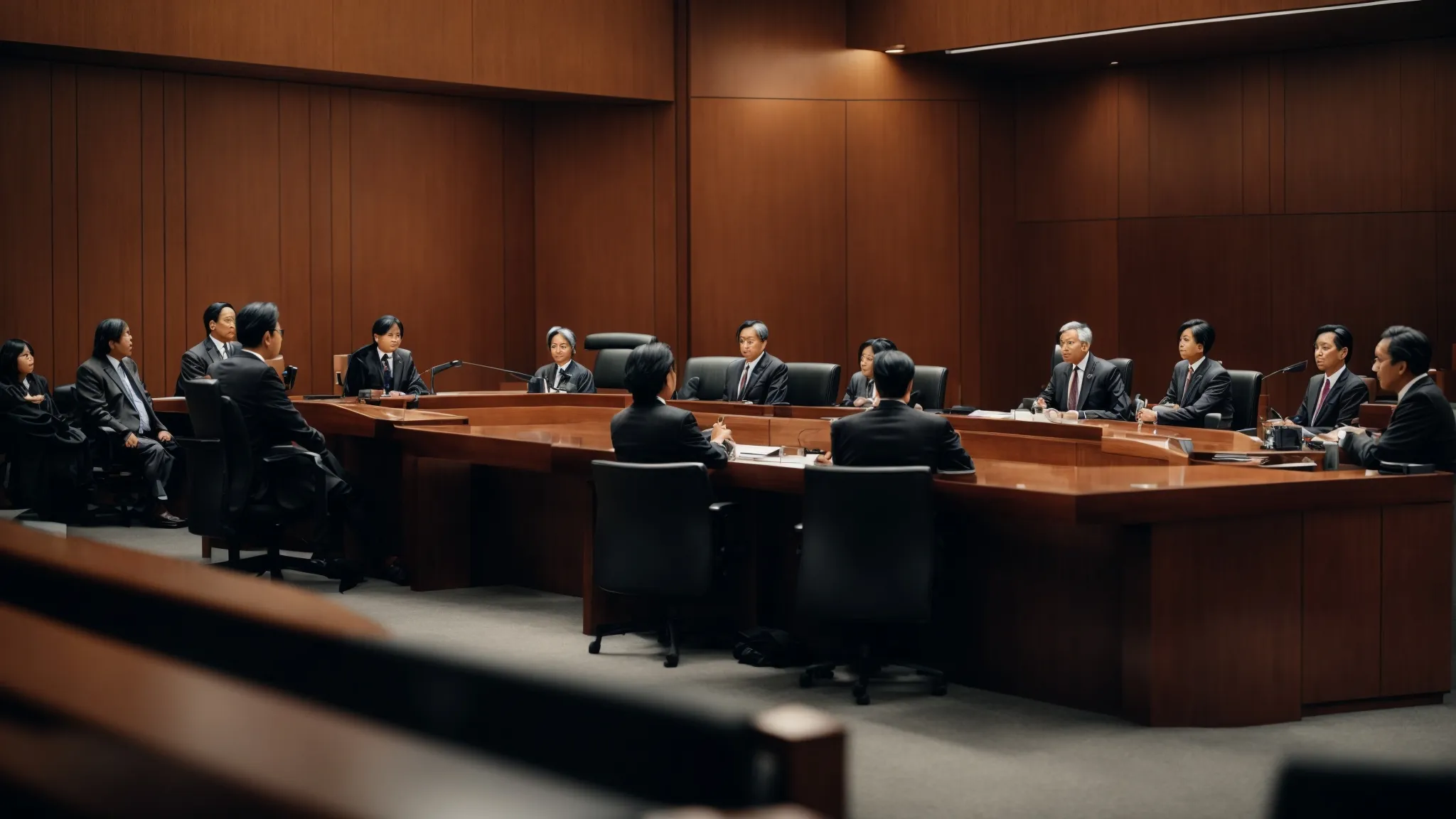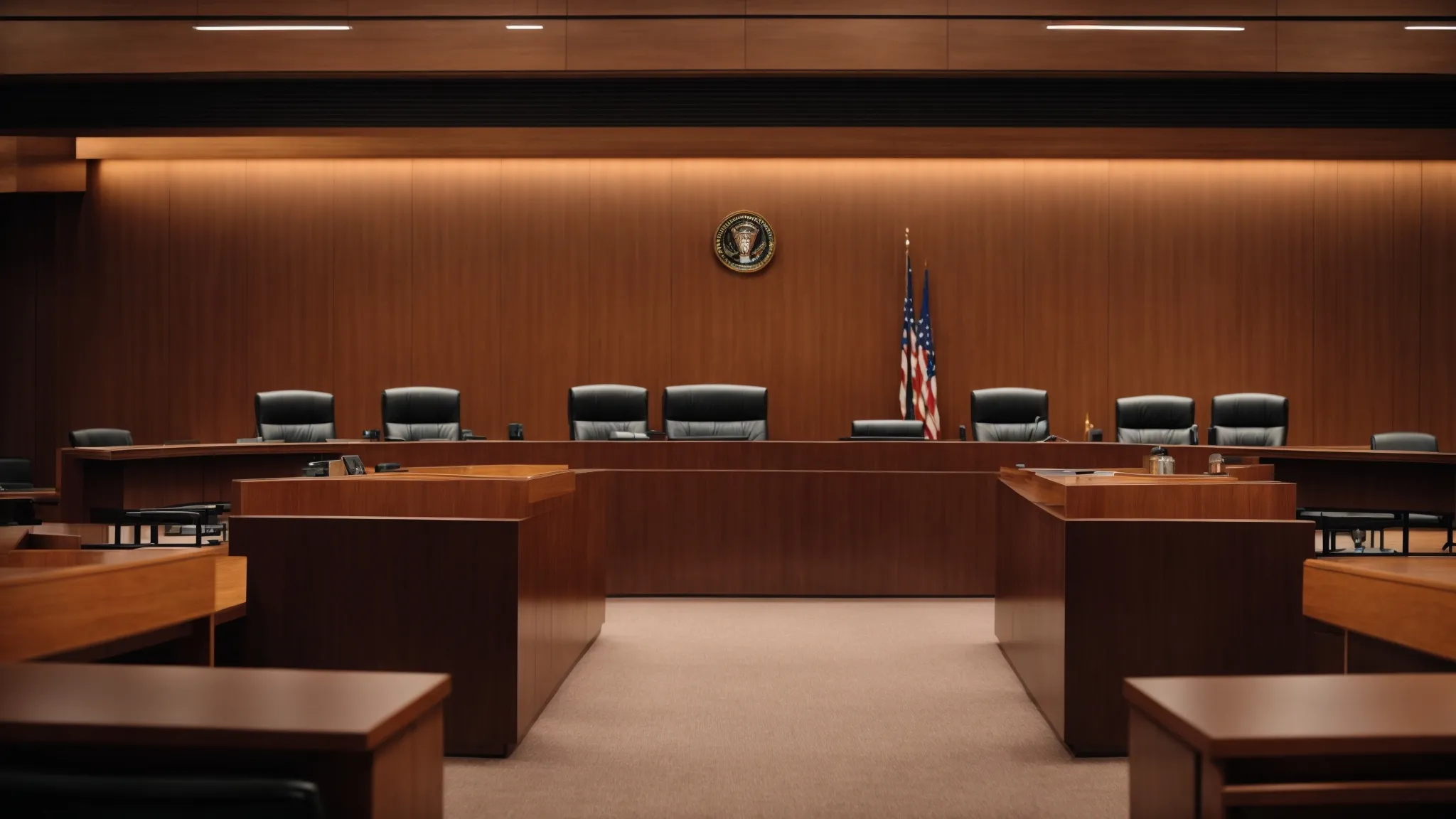Investor-State Dispute Settlement, a significant element of international investment law, serves as a linchpin for upholding the balance between corporations and host nations. At its core, ISDS provides a legal platform for investors to challenge states for alleged discriminatory practices, ensuring that trade and investment proceed under the umbrella of justice and the rule of law. Transnational Matters PLLC steps into these complex scenarios, wielding deep expertise to represent parties in navigating the labyrinthine processes from claim initiation to arbitration. As disputes within this realm become increasingly intricate, illuminating the often-opaque mechanisms of ISDS is essential. Thus, it is essential to understand the ISDS Mechanism.
Keep reading to unravel the sophisticated tapestry of ISDS, where legal prowess meets the intricacies of global investment protection.
Key Takeaways
- ISDS Provides a Legal Mechanism to Resolve Disputes Between Investors and Host States Outside of Domestic Courts
- Historical ISDS Cases Shape Current Practices and Influence the Outcomes of New Disputes
- Arbitration Rules, Whether Ad-Hoc or Institutional, Dictate the Procedure and Outcome of ISDS Claims
- There Is Growing Scrutiny and Demand for ISDS Reform, With Transparency and Fairness at the Core of Discussions
- Proposed ISDS Reforms May Lead to the Establishment of an Investment Court System, Impacting Future International Investment Landscapes
Defining the Role of ISDS in International Investment

The Investor-State Dispute Settlement (ISDS) process emerges as a pivotal construct in the realm of international investment.
Serving as a foundational tool, ISDS offers a formal avenue for resolving conflicts between foreign investors and host states under the auspices of established legal frameworks.
ISDS is rooted in the principle of investment protection, providing reassurance to corporations and investors that should disputes arise, a mechanism exists beyond national courts to adjudicate claims impartially.
With the fabric of ISDS woven into investment treaties and free trade agreements such as the Australia Free Trade Agreement, its architecture aims to sustain the balance between state sovereignty and investor rights against arbitrary actions, including expropriation without fair compensation.
The nuances of ISDS extend to safeguarding the rule of law in cross-border economic activities, where the provisions of international trade and investment law reinforce a transparent and predictable legal environment.
Understanding the Origins and Purpose of ISDS
The origin of ISDS can be traced back to the complexities of post-World War II economic reconstruction, where the need for a robust system to protect international investors became apparent. This heralded the inclusion of ISDS clauses in a myriad of bilateral investment treaties (BITs), aiming to foster a stable investment climate by providing investors with a direct recourse against host nations that might contravene treaty obligations and host countries.
ISDS was designed with the purpose of upholding the tenets of fairness and neutrality in disputes involving states and foreign investors. It acts as a guarantee for parties that should a conflict arise, their case will be heard and decided upon by impartial arbitrators rather than potentially biased local courts, enhancing the credibility of international investment agreements.
| Era | Development | Relevance to ISDS |
|---|---|---|
| Post-WWII | Creation of Bipartite Investment Treaties | Fostering a stable investment environment with protective measures for foreign investors |
| Modern Day | Maturation of ISDS Mechanisms | Assuring fairness and neutrality in international investment disputes |
ISDS as a Protection Mechanism for Investors
The ISDS framework stands as a sentinel, ensuring investors against the capriciousness of host nation policies that might otherwise infringe upon foreign investments without a channel for redress. It emboldens corporations to pursue opportunities, knowing there exists a recourse undergirded by treaties, making transnational investments less hazardous and more attractive.
By installing a structure through which claims of unfair treatment can be impartially arbitrated, ISDS reinforces the investment protection landscape. This dispute-resolution mechanism fosters an environment where the sanctity of international investment agreements is maintained, thereby upholding the integrity of trade and investment on a global scale.
The Legal Framework Underpinning ISDS Agreements
The legal infrastructure of ISDS originates from various international covenants that aim to offer a level playing field for resolving investment disputes. This includes the foundational principles set out by the United Nations Commission on International Trade Law (UNCITRAL Rules) and the World Trade Organization, shaping a framework that is both rigorous and impartial:
- The framework starts with a host nation entering into Investment Agreements (IIAs) which typically include ISDS provisions, enabling foreign investors to bypass domestic courts.
- Upon the initiation of a dispute, complex negotiation and consultation phases ensue, underpinned by the strict procedural rules defined in the investment treaty’s chapter on dispute settlement.
- If the conflict escalates, it is then ushered into adjudication before an appointed tribunal, which is bound to consider the arguments, evidence, and counterclaims presented in formal pleadings by the parties involved.
Arbitrators selected from lists provided by the disputing parties or from neutral bodies adjudicate based on the rules of law agreed upon in the trade agreement or investment treaty. The ISDS system necessitates their decisions comply with notions of fairness and equitableness, capturing the essence of international investment law while promoting the rule of law within host country states.
The Process of Initiating an ISDS Claim

Commencing an ISDS claim beckons with the identification of a potential violation of investment treaty obligations, marking a critical juncture for an investor.
It’s a process charged with intricate legal considerations, where investors must meticulously discern the nature of the breach and marshal evidence to substantiate their claims.
Upon confirming a treaty infraction, the pathway unfurls, guiding the aggrieved party through the procedural labyrinth that begins with a formal notification to the host state.
This step ushers in the notification and consultation phase, a period characterized by diplomatic dialogue aimed at resolving the issue amicably before formal proceedings take root.
Thus, laying the groundwork for a claim under ISDS is a deliberate march, preconditioned on careful analysis and strategic foresight. Please visit Investment Treaties: A Guide For Investors – Transnational Matters to find the proper resources to find the corresponding Treaty.
Identifying a Breach of Investment Treaty Obligations
The journey through Investor-State Dispute Settlement begins with a pivotal moment: uncovering a prima facie infringement of the rules enshrined in investment treaties. The investor must evaluate the actions of the host state that potentially contravene the agreed-upon terms, an assessment that demands an acute understanding of the treaty and the nuances of international investment law.
This initial scrutiny serves as a critical filter to determine whether the investor’s situation merits a formal claim under the ISDS framework. In this preliminary stage, the investor is tasked with deciphering the intricate layers of the treaty to establish the legitimacy of their grievance:
- A comprehensive examination of the investment agreement terms.
- Detailed documentation of the host nation’s actions or omissions.
- Correlation of the host state’s behavior with the investor’s legal entitlements.
Taking the First Steps Towards Filing a Claim
Embarking on the journey to file an ISDS claim calls for an investor to notify the host state regarding the alleged treaty violation officially. This formal notification, a prerequisite to any legal proceedings, is a clear signal to the host state of the investor’s intent to pursue remediation under the auspices of the investment treaty.
Following notification, meticulous preparation sets the stage for the next pivotal move: submitting a request for arbitration. This critical document articulates the essence of the grievance and lays out the investor’s expectations for resolution, effectively initiating the formal dispute settlement process:
- Drafting a comprehensive request for arbitration that delineates the investor’s case.
- Ensuring alignment between the claim and the procedural requisites defined by applicable international investment agreements.
- Appointing qualified legal representation to navigate the complexities of international arbitration.
Understanding the Notification and Consultation Phase
At the heart of the initial stages of ISDS lies the notification and consultation phase, a critical period during which the investor and host state engage in dialogue. This phase is designed to exhaust all possibilities for a negotiated settlement before the commencement of arbitration proceedings, enabling both parties to explore the contours of the dispute and seek a mutual agreement.
- Issue a written notification to the host state detailing the alleged treaty violations.
- Enter consultations with the host state to attempt an amicable resolution.
- Prepare to proceed to arbitration if negotiations reach an impasse.
The essence of this phase is underscored by its potential to diffuse tensions and foster an environment conducive to resolution sans the rigors and costs associated with formal arbitration. It constitutes a procedural safeguard, incentivizing good faith negotiation while outlining the preliminary contours for potential adjudication should consultations fail to yield a settlement.
Key Actors in the ISDS Arbitration Framework

Within the arena of Investor-State Dispute Settlement, three primary pillars stand steadfast: the investor, the host state, and the tribunal of arbitrators.
Each wields distinct responsibilities and power dynamics that intricately dictate the ebb and flow of the dispute resolution process.
As proceedings unfold, the investor champions their claim, articulating grievances and invoking treaty protections, while the state shoulders the onus of its international obligations under intense scrutiny.
Meanwhile, arbitrators, the arbiters of justice in this transnational court, exert significant influence through their interpretations and decisions, ultimately shaping the trajectory and resolution of complex international investment disputes.
The Role of the Investor in the Dispute
In the tableau of ISDS arbitration, the investor carries the mantle of the claimant, charged with the task of presenting a compelling case that articulates the alleged treaty breaches by the host state. Their role is to put forth a persuasive narrative supported by robust evidence that substantiates their claim of unfair treatment or direct injury to their investments.
The vigor with which an investor pursues their claim can often set the tone for the duration and intensity of ISDS proceedings. It is the investor who initiates the dispute settlement process, driving it forward with strategic legal positioning and clarity in the communication of their grievances to the tribunal of arbitrators.
Identifying State Responsibilities in ISDS Cases
In the mosaic of ISDS, the host state undertakes a defensive role, responding to allegations made by investors. It is incumbent upon the government to justify its actions or regulations that purportedly infringe upon the protections guaranteed by investment agreements, thus maintaining its commitment to the rule of law while upholding its sovereign right to regulate within its borders.
Within ISDS proceedings, the host state bears the obligation to counter the claims raised by the investor, presenting its case with rigor and supporting evidence. The state’s legal team must navigate the complexities of investment law, ensuring their defense aligns with international standards and the terms of the specific investment treaty in question.
Arbitrators’ Influence on the Outcome of Disputes
The arbitrators wield considerable influence in the ISDS process, with their interpretations and applications of international law essentially determining the outcome of disputes. They operate as neutral adjudicators, tasked with deciphering complex legal arguments and evidence to adjudicate claims fairly.
| Arbitrators’ Function | Impact on Proceedings |
|---|---|
| Interpretation of Law | Decision-making aligns with international legal standards |
| Assessment of Evidence | Outcomes hinge on impartial evaluation of presented facts |
Their decisions not only resolve individual cases but also contribute to the evolving jurisprudence of investment law, potentially influencing the climate of international trade and investment. Hence, the selection of arbitrators is a strategic consideration for both investors and host states, as their expertise and perspective could tilt the scales in complex investment disputes.
Unveiling the Arbitration Rules in ISDS Mechanisms

The labyrinthine domain of Investor-State Dispute Settlement embodies a procedural framework where the arbitration rules play a pivotal role in guiding the adjudicative process.
Prominent among these are the rules established by the International Centre for Settlement of Investment Disputes (ICSID), as well as those advanced by the United Nations Commission on International Trade Law (UNCITRAL), each of which delineates a path through the complexities of international arbitration.
These well-considered mechanisms – one favoring established institutional protocols and the other allowing the flexibility of ad-hoc arrangements – determine the conduct and progression of ISDS cases.
In scrutinizing both the ICSID and UNCITRAL arbitration rules, stakeholders garner insights into how these foundational guidelines not only shape the contours of the dispute resolution process but also illuminate the contrasts between distinct arbitration forums, enhancing the stakeholders’ strategic approach to navigating the ISDS terrain.
A Look at ICSID and UNCITRAL Arbitration Rules
In the echelons of ISDS arbitration, the arbitration rules stipulated by the International Centre for Settlement of Investment Disputes (ICSID) and the United Nations Commission on International Trade Law (UNCITRAL) serve as twin beacons guiding the dispute resolution voyage. While ICSID’s rules provide a comprehensive institution-backed framework, UNCITRAL paves the way for a more flexible, ad hoc approach, allowing involved parties to tailor the proceeding details more closely to their specific needs.
The ICSID arbitration rules are geared towards furnishing an all-encompassing procedural infrastructure, ensuring consistency and efficacy in addressing investor-state conflicts. UNCITRAL, in contrast, excels in offering procedural versatility, accommodating a diverse array of conflicts under its ambit, whether they stem from Trade and Investment disputes or issues involving investment protection and expropriation:
- ICSID arbitration rules speak to efficiency and uniformity in international investment dispute resolution.
- UNCITRAL empowers parties with procedural adaptability in crafting their approach to ISDS issues.
How Arbitration Rules Shape the ISDS Process
The procedural canvas of ISDS is distinctly colored by the chosen arbitration rules, influencing the proceedings’ pace, transparency, and fairness. These rules determine how disputes are initiated, the methods for appointing arbitrators, and the format and timing of submissions, ultimately sculpting the landscape through which justice is pursued in cases of international investment disputes.
Arbitration rules underpinning ISDS shape every facet of the dispute resolution journey, from the inception of a claim to the enforcement of an award. They foster a procedural equilibrium, offering both investors and host states a structured yet dynamic forum to air grievances, seek equitable resolutions, and navigate the sensitive interplay between national interests and international investment protection.
Comparing Ad-Hoc and Institutional Arbitration
In the high-stakes environment of ISDS, the distinction between ad-hoc and institutional arbitration embodies pivotal strategic choices for the parties involved: the former offers flexibility tailored to the peculiarities of the dispute, while the latter brings the assurance of a venerable institution’s established processes. The selection between these two paradigms can profoundly influence the procedural dynamics, cost implications, and the perceived impartiality of the proceedings.
Ad-hoc arbitration allows the involved entities to customize procedures, including the selection of arbitrators and the arbitration’s locale, accommodating the uniqueness of each case: a valuable attribute in the heterogeneous landscape of international investment conflicts. Conversely, institutional arbitration, through entities like ICSID, provides a more formalized approach, complete with administrative support and a repertoire of tried and tested rules, infusing the process with a degree of predictability often sought by disputants:
| Type | Flexibility | Institutional Support | Predictability |
|---|---|---|---|
| Ad-Hoc Arbitration | High | Limited | Variable |
| Institutional Arbitration | Standardized | Robust | High |
Analyzing Past ISDS Cases and Precedents

Exploring the landscape of Investor-State Dispute Settlement, a closer examination of historical adjudications sheds light on the pivotal role that precedents play in shaping the application of ISDS mechanisms.
Significant cases serve as a testament to the evolving nature of dispute resolution in international investment, providing invaluable lessons for future arbitrations.
Analysts and practitioners alike turn to prior decisions to glean insights on trends in arbitration awards, informed by the outcomes of high-stakes conflicts between investors and sovereign states.
As the system continues to mature, these cases inform both the practice and the ever-changing norms governing the resolution of international investment disputes.
Significant ISDS Cases and Their Impact
The annals of ISDS jurisprudence are peppered with landmark cases that have profoundly influenced the trajectory of international investment law. Notable among these is the arbitration between the company Philip Morris and Uruguay, which set a precedent on the balance between investment protections and a state’s right to regulate public health, thereby elucidating the boundaries within which sovereign governments may operate without infringing on treaty obligations.
In another significant case, Ecuador was ordered to pay a substantial sum to the oil conglomerate Chevron, illustrating the potentially severe financial repercussions that nations can face when arbitrators deem that they have failed to uphold the tenets of fair treatment prescribed by investment treaties. These decisions resonate through global trade and investment corridors, impacting the strategies and risk assessments of both multinational corporations and host states. To learn more about various cases, please visit the International Centre for Settlement of Investment Disputes (worldbank.org)
Learning From Historical Dispute Resolutions
Insight into historical ISDS outcomes furnishes a roadmap for navigating future complexities inherent in investor-state arbitrations. The dissecting of precedential cases equips practitioners and parties with the foresight to anticipate tribunal behavior, often serving to streamline the arbitration process and inform strategic decision-making.
As adjudicators lean on past rulings to ensure consistency and trend adherence, learning from historical dispute resolutions underscores the nuanced evolution of ISDS jurisprudence. This retrospective analysis aids in predicting potential implications for current cases, positioning stakeholders to better align their arguments with established legal principles.
Trends in Awards and Decisions in ISDS Arbitration
Parsing through the annals of Investor-State Dispute Settlement reveals that executive decisions have ebbed and flowed, deeply influenced by the underlying tone of economic nationalism and the heightened scrutiny of international investment protections. Investigating trends, one discerns a progressive caution among arbitrators to balance investor interests with the sovereign autonomy of host states, resulting in crafting awards that reflect a meticulous interpretation of substantive legal standards.
More recently, the landscape of ISDS has witnessed a transformative approach toward the quantification of damages, veering towards a more nuanced calculation that incorporates but is not limited to lost profits, sunk costs, and future earnings potential. Awards and decisions are increasingly characterized by forensic economic analysis, underpinning the compensation granted to aggrieved investors:
- Heightened evaluation of economic nationalism’s influence on investment disputes.
- Progressive development of damages quantification, infusing awards with greater economic precision.
Current Debates and Reforms in ISDS Practices

Investor-State Dispute Settlement mechanisms represent a vital yet contentious aspect of international investment law, serving as the fulcrum of adjudication for disputes that transpire between nation-states and foreign investors.
Against a backdrop of escalating tensions over sovereignty and equitable treatment, the dialogues surrounding the practices of ISDS are charged with calls for reform.
Probing into the heart of ISDS criticism reveals a spectrum of concerns, leading to a concerted push for substantial changes in resolving such disputes.
The implications of these debates and potential reforms are profound, signaling an impending metamorphosis in the proceedings of future investor-state disputes that could reshape the landscape of global investments and the rule of law.
Scrutinizing the Criticism of ISDS Mechanisms
Within the discourse on investor-state dispute resolution, ISDS mechanisms have come under extensive scrutiny from varied quarters, including legal experts, civil society organizations, and nations. Critics underscore concerns relating to transparency, arbitrator impartiality, and the balance of power between investors and states, pointing to a disparity that could undermine national sovereignty and public interest in favor of corporate benefits. UNCTAD publications shed light on these concerns.
The synthesis of oppositional views has galvanized a movement demanding ISDS reform, where suggestions proffer more stringent rules in the selection of arbitrators and the procedural regularity of the ISDS process. This heightened critical perspective seeks to recalibrate the equilibrium of international investment law, ensuring that all parties stride a level playing field within the arbitration milieu.
Ongoing Reform Efforts and Proposed Changes
As the contemporary international community confronts the complexities of global investment, concerted movements emerge, pressing for significant ISDS amendments. Transformative reform endeavors seek to enhance transparency, foster greater public participation, and ensure the impartiality of arbitrators, aligning ISDS with contemporary standards of democratic accountability and justice.
In response to these pressing calls for reform, entities such as the United Nations and the European Union are spearheading initiatives to introduce comprehensive changes to the ISDS framework. These proposed changes aim to establish an investment court system, a move that would mark a departure from traditional arbitration models and potentially instill a new degree of legitimacy to the dispute settlement process. The World Trade Organization is actively involved in these negotiations, alongside other parties involved in bilateral investment treaties and free trade agreement s.
| Entity | Initiative | Focus of Reform |
|---|---|---|
| United Nations | Reform Proposals | Enhanced Transparency, Public Participation |
| European Union | Investment Court System | Accountability, Legitimacy in Adjudication |
Implications of Reforms for Future Investor-State Disputes
The advent of reforms in ISDS practices carries the potential to fundamentally alter the dispute landscape between investors and sovereign states, recalibrating the expectations and strategies of all parties involved. With redesigned frameworks, future investor-state disputes may evolve towards an arena where enhanced rules of engagement offer a more level playing field and accessible adjudication process.
Should the proposed reforms crystallize, they promise to inject a new measure of rigor and accountability into the ISDS system, thereby impacting the negotiation postures and investment decisions of multinationals and host states alike. This shift could result in not only an increase in the predictability of outcomes but also a shift toward greater adherence to national regulatory autonomy and international rule of law standards.
Conclusion
Investigating the intricacies of Investor-State Dispute Settlement (ISDS) mechanisms is crucial for understanding their role in safeguarding international investments.
ISDS provides a crucial avenue for resolving disputes impartially, protecting investors against unfair treatment by host states.
Originating from post-WWII economic complexities, ISDS has evolved through key cases and precedents, shaping its framework to balance state sovereignty and investor rights.
With arbitrators playing a significant role in decision-making, the choice between ICSID and UNCITRAL arbitration rules influences the dynamics of dispute settlement.
Amidst ongoing debates, calls for ISDS reforms stress the need for enhanced transparency and impartiality, with the potential to transform future investor-state relations by creating a more equitable and predictable dispute resolution environment.
Understanding ISDS mechanisms helps stakeholders navigate the evolving landscape of international investment with greater confidence and foresight. At Transnational Matters, we understand these complexities and are always here to help. Contact our office today!


